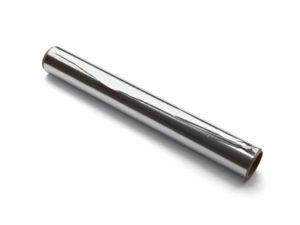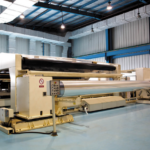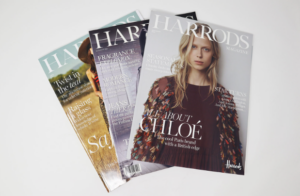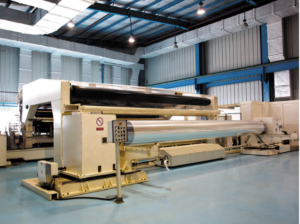For the longest time, tin, known as tinfoil stuck, was used as a packaging material for containing goods such as candies and cigarettes. While aluminum foil was also being used commercially, it wasn’t until 1947 that everyone’s favorite “aluminum foil” made its way into the household.
That’s right.
It’s light, inexpensive, and is insanely multipurpose. You’ve used it to package food for the freezer, wrap up those leftovers, line your baking sheets and oven grill grates and even sharpen scissors.

Today, aluminum foil comes in a host of different widths and sizes. As a matter of fact, the more the thickness of a foil, the less likely it will be vulnerable to tear and leak. A heavy-duty aluminum foil obviously is way thicker than a regular one. If you’re unsure about the different types of aluminum foil and how to choose one for household use, keep reading to find answers to all your questions!
Standard Duty Foil vs. Heavy Duty Foil
Aluminum foils are broadly classified into regular or standard duty foil and heavy duty foil. Just like plastic or metal sheets, aluminum foil too comes in varying thicknesses and widths. However, heavy-duty foil is thicker and is resistant to wear, tear, and puncture.
Choosing a household aluminum foil depends on where and how you intend to use it.

Following are the approximate gauges for foils used in the household, mainly in the kitchen:
Standard Duty Aluminum Foil: 0.00062. Less thick than its heavy-duty counterpart, Standard Duty Foil serves as a versatile all-purpose foil for food packaging and storage.
Heavy-Duty Aluminum Foil: 0.0009. The Heavy Duty Foil is thicker than the Standard Duty foil, and therefore, is more resistant to wear and tear.
Choosing the Right Household Aluminum Foil
Standard Duty Aluminum Foil
If you’re looking for a pocket-friendly solution for a multitude of different applications, standard-duty aluminum foil can be your savior. Not only is it inexpensive, but it is also one of the most common foodservice foil out there. In addition, it provides an all-purpose solution for most kitchen-related tasks. So whether you’re packaging food for freezer storage, or wrapping meats on the grill, this standard duty aluminum foil won’t disappoint you.
Common Applications of Standard Duty Aluminum Foil
- Wrapping meats for freezer
- Containing melted cheese
- Preparing steam chicken and fish
- Wrapping baked potatoes
- Wrapping sandwiches and flatbread
- To cover stainless steel table pans (full or half size) and foil steam table pans (full size)

Heavy-Duty Aluminum Foil
If you’re looking for a more durable option that can withstand wear and tear during usage, look no further than a heavy-duty aluminum foil. Manufactured thick enough to resist puncture and tear, heavy-duty aluminum foils are perfect for covering foil steam table pans. It’s because pans tend to flex when carried, and only a heavy-duty foil can help with that.
Typical Applications of Heavy Duty Aluminum Foil
- Using as a temporary yet durable lid
- Lining grilling gates, covering grills, and ovens
- Lining pans use for baking, steam cooking, roasting, and broiling
- Keeping stainless steel pans protected during transport
- Covering all sizes of steam table pans
What is the Difference Between Aluminum Foil Rolls and Aluminum Foil Sheets?
Household aluminum foil is typically available as rolls or sheets. With rolls, there’s always an adequate amount of foil wrapped around, which you can use whenever you want in any desired quantity. Aluminum foil rolls come in handy when you need to use the foil on a regular basis. Another notable feature of these rolls is standard finish and non-stick finish options. The latter ones have a shiny glazed surface on one side, allowing you to use them in oil-free cooking as they are easier to detach. Aluminum foil rolls are ideal for use in lining pans, ovens, and grills.

Different manufacturers make aluminum foil rolls in a range of widths. Commonly available widths include 12″,15″,18″, and 24″. While aluminum foil rolls make the appropriate amount of the foil readily available at your disposal, you need to tear them according to use.
This is where aluminum foil sheets come in.
This type of aluminum foil provides already cut sheets in specific sizes, which saves your time from the hassle of unrolling foil sheets, and then measuring the desired amount before finally cutting them. The sheets come in handy, especially when you’re on a time crunch, so you can use them to wrap your food on the go.
Aluminum foil sheets are perfect for wrapping cooked food such as sandwiches, burgers, hot dogs, granola bars, baked potatoes, etc. Some commonly available sizes of aluminum foil sheets are 9″ x 10 3/4″ sheets, 12 x 10 3/4″ sheets, and 14″ x 16″ sheets.
Conclusion
Aluminum foil is a household essential. Since it’s mainly used to store, carry, and contain foods and kitchen utensils, choosing the suitable aluminum foil is super important. Understanding the different types of foils, their thickness, and their width range can give a clear picture of which foil works best for which purpose. If you’re looking for something tough and resilient, opt for a heavy-duty variety of aluminum foil. Not only will it serve the purpose, but it will also make wrapping and packaging effortless. The best part? Aluminum foils are fully recyclable, so no matter where you are, you can always toss your use aluminum foil in the recycle bin and contribute towards building a sustainable environment.







